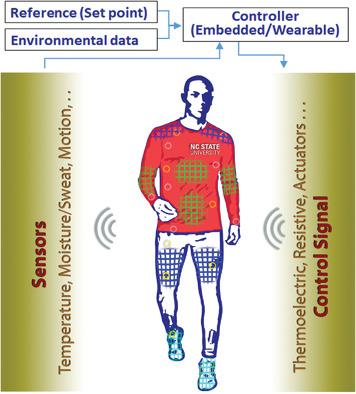当前位置:
X-MOL 学术
›
Adv. Mater. Technol.
›
论文详情
Our official English website, www.x-mol.net, welcomes your feedback! (Note: you will need to create a separate account there.)
Smart Textile‐Based Personal Thermal Comfort Systems: Current Status and Potential Solutions
Advanced Materials Technologies ( IF 6.8 ) Pub Date : 2020-03-17 , DOI: 10.1002/admt.201901155 Jordan Tabor 1 , Kony Chatterjee 1 , Tushar K. Ghosh 1
Advanced Materials Technologies ( IF 6.8 ) Pub Date : 2020-03-17 , DOI: 10.1002/admt.201901155 Jordan Tabor 1 , Kony Chatterjee 1 , Tushar K. Ghosh 1
Affiliation

|
Thermophysiological comfort in humans is sought universally but seldom achieved due to biological and physiological variances. Most people in developed parts of the world rely on highly energy‐intensive, and inefficient central heating/cooling systems to achieve thermophysiological comfort which is rarely satisfactory. A potential solution to this issue is a wearable personal thermal comfort system (PTCS) consisting of textile‐based temperature and moisture sensors, thermal and moisture responsive actuators, and/or heating/cooling devices, that can sense the environment and physiology of the wearer, and accordingly provide an individualized thermal environment. Moving thermal regulation away from the built environment to the microclimate surrounding the human body using textiles has the potential to provide personalized thermal comfort and energy savings. Such a system may employ thermal comfort models and leverage the Internet of Things (IoT) and machine learning (ML) to understand individuals' comfort requirements. Herein, the current state of textile‐based active and passive comfort systems/technologies are summarized, including their environmental impact, major thermal comfort models, and factors influencing comfort. Also, active and passive textile‐based devices (sensors, actuators, and flexible heating/cooling devices) that may be incorporated into a textile‐based wearable PTCS are comprehensively discussed with an emphasis on their advantages, limitations, and prospects.
中文翻译:

基于智能纺织品的个人热舒适系统:现状和潜在解决方案
人们普遍寻求人类的热生理舒适性,但是由于生物学和生理方面的差异而很少达到。世界上发达地区的大多数人都依靠高度能源密集和效率低下的中央供暖/制冷系统来获得热生理舒适度,而这种舒适度很难令人满意。该问题的潜在解决方案是可穿戴的个人热舒适系统(PTCS),该系统由基于纺织品的温度和湿度传感器,对温度和湿度敏感的执行器和/或加热/冷却装置组成,可以感知穿戴者的环境和生理状况,从而提供个性化的热环境。使用纺织品将热调节从建筑环境转移到人体周围的微气候,有可能提供个性化的热舒适性和节能效果。这样的系统可以采用热舒适度模型,并利用物联网(IoT)和机器学习(ML)来了解个人的舒适度要求。本文总结了基于纺织品的主动和被动舒适系统/技术的当前状态,包括它们对环境的影响,主要的热舒适模型以及影响舒适性的因素。此外,对可结合到基于纺织品的可穿戴式PTCS中的主动和被动基于纺织品的设备(传感器,致动器和柔性加热/冷却设备)进行了全面讨论,重点是它们的优点,局限性和前景。这样的系统可以采用热舒适度模型,并利用物联网(IoT)和机器学习(ML)来了解个人的舒适度要求。本文总结了基于纺织品的主动和被动舒适系统/技术的当前状态,包括它们对环境的影响,主要的热舒适模型以及影响舒适性的因素。此外,对可结合到基于纺织品的可穿戴式PTCS中的主动和被动基于纺织品的设备(传感器,致动器和柔性加热/冷却设备)进行了全面讨论,重点是它们的优点,局限性和前景。这样的系统可以采用热舒适度模型,并利用物联网(IoT)和机器学习(ML)来了解个人的舒适度要求。本文总结了基于纺织品的主动和被动舒适系统/技术的当前状态,包括它们对环境的影响,主要的热舒适模型以及影响舒适性的因素。此外,对可结合到基于纺织品的可穿戴式PTCS中的主动和被动基于纺织品的设备(传感器,致动器和柔性加热/冷却设备)进行了全面讨论,重点是它们的优点,局限性和前景。总结了基于纺织品的主动和被动舒适系统/技术的当前状态,包括它们对环境的影响,主要的热舒适性模型以及影响舒适性的因素。此外,对可结合到基于纺织品的可穿戴式PTCS中的主动和被动基于纺织品的设备(传感器,致动器和柔性加热/冷却设备)进行了全面讨论,重点是它们的优点,局限性和前景。总结了基于纺织品的主动和被动舒适系统/技术的当前状态,包括它们对环境的影响,主要的热舒适性模型以及影响舒适性的因素。此外,对可结合到基于纺织品的可穿戴式PTCS中的主动和被动基于纺织品的设备(传感器,致动器和柔性加热/冷却设备)进行了全面讨论,重点是它们的优点,局限性和前景。
更新日期:2020-03-17
中文翻译:

基于智能纺织品的个人热舒适系统:现状和潜在解决方案
人们普遍寻求人类的热生理舒适性,但是由于生物学和生理方面的差异而很少达到。世界上发达地区的大多数人都依靠高度能源密集和效率低下的中央供暖/制冷系统来获得热生理舒适度,而这种舒适度很难令人满意。该问题的潜在解决方案是可穿戴的个人热舒适系统(PTCS),该系统由基于纺织品的温度和湿度传感器,对温度和湿度敏感的执行器和/或加热/冷却装置组成,可以感知穿戴者的环境和生理状况,从而提供个性化的热环境。使用纺织品将热调节从建筑环境转移到人体周围的微气候,有可能提供个性化的热舒适性和节能效果。这样的系统可以采用热舒适度模型,并利用物联网(IoT)和机器学习(ML)来了解个人的舒适度要求。本文总结了基于纺织品的主动和被动舒适系统/技术的当前状态,包括它们对环境的影响,主要的热舒适模型以及影响舒适性的因素。此外,对可结合到基于纺织品的可穿戴式PTCS中的主动和被动基于纺织品的设备(传感器,致动器和柔性加热/冷却设备)进行了全面讨论,重点是它们的优点,局限性和前景。这样的系统可以采用热舒适度模型,并利用物联网(IoT)和机器学习(ML)来了解个人的舒适度要求。本文总结了基于纺织品的主动和被动舒适系统/技术的当前状态,包括它们对环境的影响,主要的热舒适模型以及影响舒适性的因素。此外,对可结合到基于纺织品的可穿戴式PTCS中的主动和被动基于纺织品的设备(传感器,致动器和柔性加热/冷却设备)进行了全面讨论,重点是它们的优点,局限性和前景。这样的系统可以采用热舒适度模型,并利用物联网(IoT)和机器学习(ML)来了解个人的舒适度要求。本文总结了基于纺织品的主动和被动舒适系统/技术的当前状态,包括它们对环境的影响,主要的热舒适模型以及影响舒适性的因素。此外,对可结合到基于纺织品的可穿戴式PTCS中的主动和被动基于纺织品的设备(传感器,致动器和柔性加热/冷却设备)进行了全面讨论,重点是它们的优点,局限性和前景。总结了基于纺织品的主动和被动舒适系统/技术的当前状态,包括它们对环境的影响,主要的热舒适性模型以及影响舒适性的因素。此外,对可结合到基于纺织品的可穿戴式PTCS中的主动和被动基于纺织品的设备(传感器,致动器和柔性加热/冷却设备)进行了全面讨论,重点是它们的优点,局限性和前景。总结了基于纺织品的主动和被动舒适系统/技术的当前状态,包括它们对环境的影响,主要的热舒适性模型以及影响舒适性的因素。此外,对可结合到基于纺织品的可穿戴式PTCS中的主动和被动基于纺织品的设备(传感器,致动器和柔性加热/冷却设备)进行了全面讨论,重点是它们的优点,局限性和前景。



























 京公网安备 11010802027423号
京公网安备 11010802027423号